#Redevelopment road works
Explore tagged Tumblr posts
Text
Infrastructure Development with Renovation of Bahçeli Village Road
The Turkish Republic of Northern Cyprus (TRNC) is witnessing a significant development in its infrastructure with the renovation of the Bahçeli Village Road. This project, spearheaded by the Minister of Public Works and Transport, Erhan Arıklı, marks a pivotal step towards enhancing the connectivity and accessibility of the region. Continue reading Infrastructure Development with Renovation of…

View On WordPress
#Bahçeli Village Road#Ministry of Public Works and Transportation#Redevelopment road works#statement#TRNC
0 notes
Text
**Veilguard criticism incoming**
In Veilguard, none of the companions are important to the main storyline. Each one could be missing or replaced and it would have little impact on the plot. Of course most companions in previous games also weren’t tied directly to the main story line, but in each game at least one was. Alistair could become king of fereldan, Morrigan could do her archdemon baby ritual and save your characters life, Isabela caused the arishok to invade Kirkwall, Varric and Bartrand take you on the deep roads expedition that uncovers the red lyrium idol, Cassandra and Lelianna form the inquisition, Solas is Solas, etc. In Veilguard, no character has that kind of impact on the story. Even Harding, who was part of the inquisition and now has a direct connection to the titans, somehow has little to no influence on the plot. You learn more about the titans through Solas’s memories than from Harding’s entire quest line. (From what I remember at least, if that’s wrong please correct me). Lucanis and Neve are both tied to powerful Venatori, but their conflicts feel insular and are never tied back to the main storyline of the gods (other than ‘Venatori work for the gods’). Bellara’s storyline is about a literal Forgotten One and even it falls flat. I think that’s why there’s a larger issue of the elven gods feeling like a side plot in the game rather than the main story line, as you spend most of your time on companion and faction quests that seem disconnected from the gods.
**This is not hate towards the writers! They were forced to develop and redevelop this story on an unrealistic timeline and I’m glad we got a decent game at all. Seeing early ideas from the art book and other sources just makes me mourn the game we could’ve gotten**
40 notes
·
View notes
Text



Disque 957 (1928)
[letterboxd | imdb]
Director: Germaine Dulac
Camera: Alfred Guichard
“The whole problem of cinema lies in its definition. Is real cinematic thought a philosophical, poetic, commentary on an event or an action in which images have only the value of a word or a sentence? Is it a faithful vision of life applied to the illustration of an idea? An unoriginal theme, could that not be the consequence of the destructive intrusion of literary forms into the cinema? "By literary intrusion I mean the technical device which is used to move us by the antiquated formulas of storytelling, plot exposition and resolution, according to the tradition of psychological mystery or drama, which constitute the basis for written or acted dramas. "In my opinion, this way of thinking about action has pushed cinema down a very bad road. Is there not action enough in motion itself which can change, evolve, and develop? “But why must action be subject to a dramatic situation as in the theater? Can we not conceive of an action based on the development of simple emotions as in music?[...] “Cinematic action? A feeling! The film a visual symphony. Down with storytelling!”
— “The True Spirit of the Seventh Art” by Germaine Dulac. Le Soir, 16 April 1925 [1] (emphasis mine)
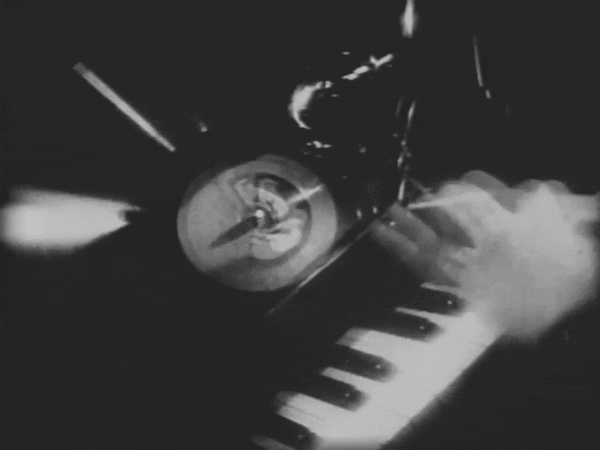


If you’ll allow me to be overdramatic for a moment, Germaine Dulac spent the 1920s engaged in a battle for the soul of cinema. Dulac was a renaissance woman: a filmmaker, theorist, critic, activist, and journalist. Dulac articulated her theories on the potential of film as an artform through articles (like the one quoted above), lectures, and interviews, while also taking every opportunity to test those theories in making her own films.
Cinema in the 1920s showed abundant signs of artistic stagnation, not just in France but in all capitalist countries (though each nation’s industry had their own flavour of stagnation). The French industry was struggling to build up film production after the devastation of the First World War. To make matters worse, distribution and exhibition markets in France were flooded with American imports. This is admittedly an oversimplification, but these factors directly fed into the growth of a purely commercial approach to cinema. It's easy to understand why Dulac felt a sense of urgency in fighting for a more expansive, artistic approach to filmmaking.
Dulac even-handedly observed in her writing/lecturing that the state of filmmaking in the 1920s was an artistic endeavor out of balance with its commercial element; that imbalance born out of the ever dominant profit motive. What that looked like on film was an insistence on a rote form of narrative filmmaking, overly reliant upon devices and conventions (mis)appropriated from literary or dramatic storytelling. This insistence was and is driven by the conservatism that pure profit motive engenders. Pushing the boundaries of an artform or experimenting with what that artform can accomplish is difficult (sometimes impossible) within a profit-driven industry.
Dulac’s militant stance against “literature” in cinema, shouldn’t be boiled down to an argument that novels or plays shouldn’t be adapted to film—a willfully reductive take TBH. Developed and redeveloped over years, Dulac’s ideas on this topic were shifting and dynamic. At its core, Dulac’s feeling was that directly repurposing devices from other pre-existing media was hamstringing the development of film as its own art. And, unfortunately, increased commerciality was locking cinema into a cycle of well-trodden styles and techniques that producers considered sure-fire profit. [2]

By the end of the 1920s, Dulac had amassed over a decade of filmmaking experience and had time and again used her filmmaking to investigate and fine-tune her ideas on film art. In that same moment, it became evident that sound would finally be joined to film as the standard mode. Dulac’s work had reached the apotheosis of her theories just as the medium was about to undergo a foundational shift!
Following what is regarded as her magnum opus, the impressionist film The Seashell and the Clergyman (1928), Dulac created three experimental abstract shorts that put her theories of visual rhythm to the test: Disque 957, Arabesques, and Themes and Variations. These films are a culmination of common themes in Dulac’s writing and in her films: capturing an impression, revealing inner, psychological life, and proving the film medium’s commonalities with music. Dulac sought the cinematic equivalent of a symphony. Disque 957 is an especially compelling manifestation of these ideas.
The film was intended to be projected silently—though it exists in conversation with Chopin’s preludes 5 and 6. Rather than a soundtrack, the “musicality” of the film comes from the harmony and rhythm of its images.[3] Disque 957 begins with a quote by George Sand, reflecting on the works composed by her companion, Frédéric Chopin, during their ill-fated trip to Majorca. Chopin and Sand intended to spend the winter in Majorca as Chopin was trying to recover from tuberculosis. Unfortunately, it rained torrentially for much of their stay. In Sand’s recollection, quoted at the beginning of the film, Chopin’s preludes are haunted by the sound of the rain on the tiles outside their rented house. Sand immortalized the trip in her book Un Hiver a Majorque. [4]

Disque 957 finds a swirling set of reference points in Chopin’s preludes, Sand’s recollections and Dulac’s impressions of listening to the preludes. Dulac brings these elements together to inform the moving images, their organization, and the visual rhythm that organization creates. In the end, Dulac puts to film the feeling of listening to Chopin’s preludes with the knowledge of that winter in Majorca.
In a way, Dulac’s experiment revealed hints to an alternative path where “literary” source material (here Sand’s travelogue) could provide direct inspiration for a cinematic work without sacrificing filmic art in favor of literary conventions. Disque 957 is both a cinematic snapshot of a psychological state and proof of cinema’s (yes, silent cinema’s) relationship to music.
It’s almost poetic to consider these experiments in abstraction being made just as the technological shift of sound would further cement the industry’s reliance on literary/dramatic conventions. The evolution of Dulac’s films and theories (and those of other filmmakers dedicated to the artistic development of the medium) obviously didn’t die out with the coming of sound. Many of the concepts Dulac interrogated remain relevant—especially given the current state of filmmaking. Though Dulac’s legacy is only now being restored in film history, her ideas were not erased. Many filmmakers and theorists after Dulac, including Maya Deren,[5] similarly fought for the integral poetics of film over strict narrative drama.
One of the key figures in recovering Dulac’s legacy is Professor Tami M. Williams, who wrote the must-read Germaine Dulac: A Cinema of Sensations. So, I’d like to close with a quote from Williams’ book (that in turn quotes from Dulac’s essay “Les Esthétiques”):
“For [Dulac], cinema, unlike literature, should not be recountable, but should ‘draw upon its active or emotive principals in images of visual vibrations alone.’ Of the rhythm of the images, Dulac states: ‘Their emotional value became so great, and the link between them so logical that their expression alone had value without the assistance of a text.’”
——— ——— ———
☕Appreciate my work? Buy me a coffee! ☕
——— ——— ———
[1] from Writings on Cinema, 1919-1937 by Germaine Dulac, ed. Prosper Hillairet & trans. Scott Hammen
[2] If you’ve been around the blog for a minute, this might sound familiar—it’s a related conflict to what I covered in my Salomé and Omar Khayyam essays, only from the other side of the Atlantic.
[3] This differentiates it from experimental musical films timed to be synchronized with a specific piece of music like those of Dudley Murphy, Mary-Ellen Bute, or Dulac’s own “Illustrated Record” films, which she made for Isis Films.
[4] The Sand quote used in the film is her reflection on that winter, but it's not quoted directly from the book.
[5] The French and American avant-garde have a lot of connections, but I’m not sure if Deren was exposed directly to Dulac’s films or writings. (If only Robert Haller were still with us, I would have already shot off a letter to him about it!) There are a lot of noteworthy similarities between the two filmmakers: Deren was also a theorist/filmmaker who would write articles and give lectures to accompany her films. Some of Deren’s preoccupations are clearly direct descendants of Dulac’s—her concept of innocent receptivity, her rejection of dramatic devices, and her preoccupation with scientific filmmaking—to name just a few. Maybe even more fascinating is that their films have so very little in common, though both filmmakers shared theoretical sensibilities and also a deep appreciation for dance on film. Kinda goes to show the amazing potential of film art IMO! Also, coincidentally, both filmmakers had creative disputes over their films with prominent poets: Dulac with Antonin Artaud over The Seashell and the Clergyman and Deren with Anaïs Nin over Ritual in Transfigured Time (1946).
#1920s#1928#Germaine Dulac#my gifs#cinema#film#french cinema#french film#film history#film theory#frederic chopin#george sand#cinematography#experimental film#avant-garde film#short film#women filmmakers#female film directors#abstract art#abstract film#impressionism#filmblr#black and white#classic film#classic cinema#classic movies
30 notes
·
View notes
Text
WIP ask game
Rules: make a new post with the names of all the files in your wip folder, regardless of how non-descriptive or ridiculous. tag as many people as you have wips. People send you an ask with the title that most intrigues them, then post a little snippet or tell them something about it!
Tagged by the lovely and talented @amellderiva. I’m normally a one project at a time person, but unfortunately solrook has me by the throat and the concepts(!) won’t let me whole ass one thing. We won’t bring my word counts into this because that is between me and scrivener.
More than just a dream - Solrook - my current joint. Post trick ending. You know what they say, “misery loves company” and Solas is only too happy to use their blood magic connection to remind Rook of that fact. Two chapters to go before I’m finished.
Roadwork Ahead - Solrook - Broken Roads sequel, Solas goes on life changing field trips with the gang. Also some other stuff happens, like the intense judgement from Rook’s friends about her choices. Writing multi pov is hard y’all. Emmrich internal voice one day I shall solve you 😤
Corpo AU - Solrook - modern AU where Solas works for an evil mega corporation (Evanuris Co) and has been assigned the task of acquiring all the property in the Crossroads district of the city for redevelopment. By random twist of fate the last two joints on his list are the Hanged Man, a Gentivi starred restaurant run by his old Inquisition buddy with shady connections, and the the Lighthouse, an apartment complex he lived in during his rebellious art youth phase that ended in tragedy. Unluckily for Solas, burnt-out no nonsense functional potter Rook works at one, and lives at the other and she has no problem telling him and his corporate interests to get bent. Longue fique
Wolf’s General - solrook - AU answering the question: what would need to happen for Rook to choose Solas’ side during the Arlathan Ritual? Answer: at the end of DAI instead of letting Solas take her power and dying, Flemythal says no, he failed, she will have her reckoning herself. Kicking off events that will leave Solas bereft of the power he needs and see the Qunari succeed their assassination attempt across Thedas during the events of Trespasser, including the death of the Inquisitor. This longfic has everything: depowered Solas, a Hawke rescue mission, Merrill being unhinged in a sweet and ruthless way, betrayals, weird fade shit™️, vows of profound loyalty, and eventual romance ✨
No pressure tags to the lovely @loominousfish @scriberated and @dogg0melette if you all want in on the fun
16 notes
·
View notes
Text
"why search for footprints in the dirt / let's go where the road takes us"
Fandom: Pokemon
Rating: General
Warnings: n/a
Work Summary:
The PL:Z-A hype train.... is REAL! - Behind the monument stood the gate that would connect them to Lumiose, a city which not even an year ago had been shut down entirely following a devastating attack. The city had been brought to its knees. Anio clutched his bag’s strap. Looking around, he couldn’t see a trace of that attack, everything was pristine. Perfect. As if laughing, taunting, asking if anyone had really thought it would stay down for long. - Anio and Zyde return to Lumiose after years of living in Sinnoh, right in the middle of a redevelopment run by a private company. As they catch up on everything their home has to offer, the world's largest city has more in store for them than they ever imagined. Or: a prediction/hc/anime mix story for pokemon legends: z-a based on official trailers and my brainrot. set after the kalos crisis and following original trainers.
Chapter Summary: Diantha is approached, once again, to approve Quasartico's redevelopment project.
Tags:
Relationships: Canon & OC, Canon & canon, OC & OC, Platonic Relationships - Relationship
Characters: Original Pokemon Trainer(s), Carnet | Diantha, miss jett (pokemon legends: z-a), mr. vinnie (pokemon legends: z-a), Platane-hakase | Professor Augustine Sycamore
Additional Tags: Alternate Universe - Canon Divergence, is it pre/post canon if we dont know what canon Is?, Canon Related, character tags will be updated as we go
#pokemon#kalos#quasartico#diantha#pokemon xy#pokemon legends za#fanfic#duckbang posts#duckbang writes#the plza hype train
7 notes
·
View notes
Note
Anon look at Anne’s/Gloucester’s/Sophie and Edward’s schedules there is always stuff to commemorate/open- hospitals have new wings, roads and train lines always have extensions or redevelopment. There is still enough bread and butter work for William and Kate on top of their main work.
Exactly, and I think that devotion to the mundane royal work is a big reason why Anne is so popular now.
60 notes
·
View notes
Text



The Electronics Hoarder
Don't forget there is also a detailed video showing everything left behind here!!
youtube
And finally, let's check out the second floor which surprisingly had a bit of space to breath!!
Surrounded by trees and mostly hidden from the road sits this very overgrown property that has been abandoned for at least a couple of years. Looking at photos of the home and property from just a few years ago, it was very clean inside and empty. Fast forward a few short years and the house is filled with junk throughout most of the home, including a huge stash of electronics! The yard had a lot of garbage around as well, including old tires and lumber, although most of that seems to have been cleaned up.
Then in 2021 there was a property standards committee meeting about the land after neighbours had complained. Presumably the new residents that had moved into a new small development next door overlooking the overgrown property. The town ordered the owner of the property to get it cleaned up and back to code. The owner said he was working on getting his tenant evicted before demolishing the structures to began work on a new development. I presume the home was vacated shortly after.
The application for redevelopment was to permit 5 new single detached homes on the current property. The land was later listed for sale for $3.6 million which was almost three times the value it sold for just 7 years prior! But it never sold.
#abandoned#urbex#urban exploring#urban exploration#bandos#abandoned places#abandoned buildings#forgotten#abandoned houses#forgotten buildings#abandoned homes#forgotten places#hoarders#hoarder#hoarder homes#hoarder houses#hoarding#Youtube
12 notes
·
View notes
Text
i just know that there's something sinister that's going to be at play in pokemon legends Z-A
not just because pokemon always has to have an evil team/corporate entity, but even just from what little info we have i can tell something isn't right
obviously quasartico is supposed to be the bad guys, right? and they're the ones in charge of the redevelopment plans in the first place
their current idea of what to do with lumiose city's previous design is to completely abandon it as if it were a zombie apocalypse and leave it for the grass and weeds to grow over it and for pokemon to run around and inhabit it instead
like, in the gameplay trailer, in the first wild zone, it's just a overgrown city street, with buildings and storefronts still intact, cars abandoned in the middle of the road, with pokemon running wild there for you to catch
does that... not seem strange? where did the people who lived and worked there end up going? why was the area not demolished before being designated as a zone for wild animals to live in? what will happen to it once the city is actually rebuilt? why are you even catching the pokemon in there???? you were clearly sent there on a mission by quasartico, presumably similar to how the galaxy corps used you, to either document or collect the pokemon in those areas
but why would you do that? why are you really there?
#pokemon#pokemon legends z-a#this game is clearly going to have some kind of parallels to legends: arceus#like idk how but your role seems to be similar#you get a traditional starter and rival and such#but like. you stay firmly within the city limits. and you catch the wild pokemon that inhabit the city's brand-new ruins#like... that's weird? that is weird right??? that is not a normal
5 notes
·
View notes
Text


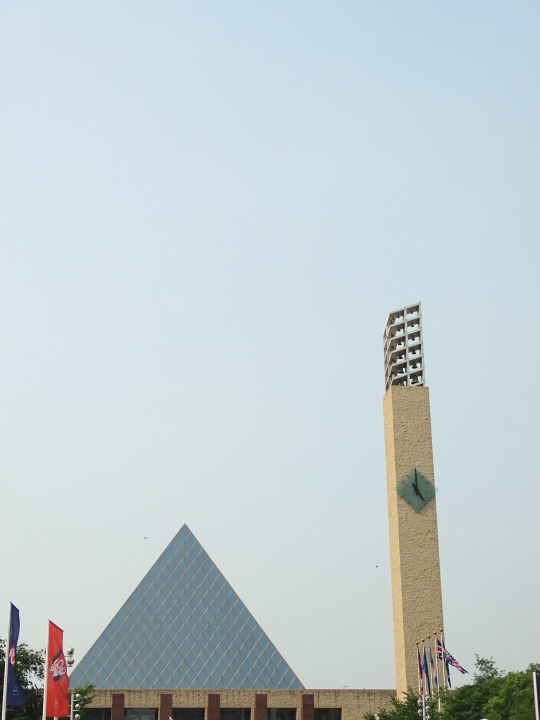



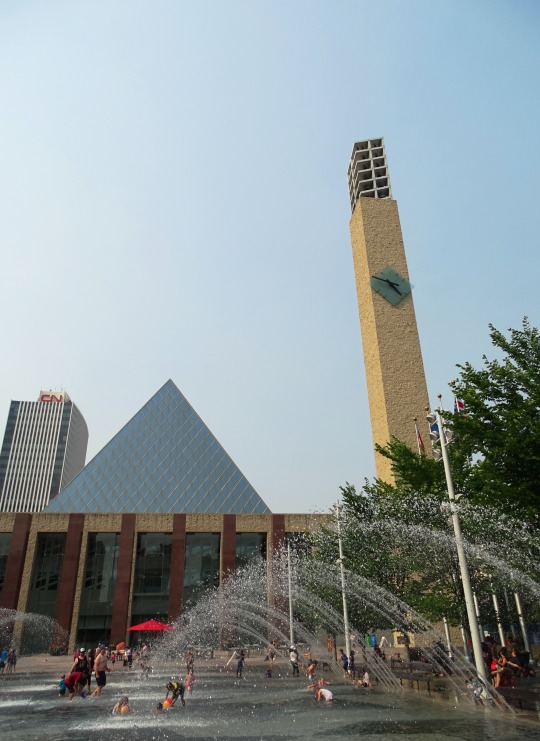



Churchill Square, Edmonton (No. 2)
Churchill Square (officially "Sir Winston Churchill Square") is the main downtown square in Edmonton, Alberta, which plays host to a large number of festivals and events including: the Edmonton International Street Performers Festival, Edmonton Fashion Week, The Works Art & Design Festival, Taste of Edmonton, Cariwest, and Edmonton Pride.
It is bordered on the north by 102A Avenue, on the west by 100 Street, on the south by Harbin Road (102 Avenue) and on the east by Rue Hull (99) Street. In 2009, 102A Avenue was closed to vehicle traffic permanently, providing easier pedestrian access to City Hall.
Surrounding the square are several cultural and governmental buildings, including Edmonton City Hall to the north, the Law Courts and the Art Gallery of Alberta to the north-east, Chancery Hall and the Francis Winspear Centre for Music to the east, the Citadel Theatre to the south-east, the Stanley A. Milner Library (the main branch of Edmonton Public Library) to the south and Edmonton City Centre mall to the west.
The centrepiece of the square builds a life-size bronze statue of Churchill, unveiled by Lady Soames on May 24, 1989. It is a copy of a statue made by Oscar Nemon.
Historically, Edmonton's main square was Market Square, located just to the south of Churchill Square, on the site of the present Milner Library. The City Market was housed in Market Square from its beginning in 1900, originally with the market happening outdoors. Successive plans were considered to develop the square into a civic centre, beginning in 1912. A building was built far away on 107 Avenue for the market to be moved indoors in November 1914, but was never used for this purpose and was boycotted by vendors and customers. The market returned to its original location and the city agreed to help construct a shelter. Beginning in 1915 the market was moved indoors, and by 1920 only overflow stalls were outside. From 1916, when the shelter was built, to 1965, when it moved off the site, the market flourished as the hub of Edmonton life. The City Market was finally shifted east to 97 Street, and the area was redeveloped according to a plan to create a "civic centre" in the area by constructing the new art gallery and library to accompany the new city hall which had been built in 1957.
In 1969, Lillian Shirt drew national media attention for protesting housing discrimination by erecting a tipi on the square. During the protest, which lasted 12 days, was joined by several others who set up tents and an additional tipi.
Churchill Square has undergone several face-lifts, the most recent, expensive, and most controversial, being completed in 2004, in time for Edmonton's Centennial Celebrations. These renovations saw the removal of a large amount of green space, as well as the building of several new structures in the square including an amphitheatre, a waterfall, as well as several structures for retail space (currently occupied by the Three Bananas Cafe and Tix on the Square).
Although Churchill Square is not the name of any street in Edmonton, and all the streets in the area are named, the square is used as the address for buildings facing it, they are numbered clockwise starting in the north.
Source: Wikipedia
#Churchill Wire Centre by Max Dewar#Sir Winston Churchill Square#City Hall Plaza#Churchill Square#Edmonton City Hall#Dub Architects#Edmonton City Hall Water Fountain#Art Gallery of Alberta by Randall Stout#Light Venturi by Terri Frost#fountain#public art#Alberta#Canada#summer 2024#travel#original photography#vacation#tourist attraction#landmark#cityscape#architecture#Edmonton#downtown#Friendship Tower
4 notes
·
View notes
Text
Man I don't even know where to start with this, but why are the people who write Pokemon games the way they are. So like, the only thing we know about Pokemon Legends: ZA is a big title card that says URBAN REDEVELOPMENT PLAN: LUMIOSE CITY. Unless the game takes place in the future (which Ive seen some people suggest) I'm willing to bet they're basing the game off of the redevelopment of Paris in the mid-1800s:
Which is like... weird? Like it created the Paris we all know and love today but it took the iron fist of the Second French Empire to do it. Do you realize how hard it is to move roads? Tens of thousands of people were displaced. Like half the point was widening the streets so they'd be harder to build barricades in. That and making it more a place for tourists and attracting foreign artists and such than a place people would actually live. It wasn't all bad, they were doing like important sanitation work and stuff, but this wasn't an uncontroversial move is all I'm saying.
It's just a weird choice! It gives me the exact same vibe as Legends: Arceus being this bizarre colonialism narrative where LITERAL GOD sends a child to the past to ensure some colonizers succeed at dominating the indigenous culture of Hokkaido. Like why is the only sort of story Game Freak wants to tell about the past about like exertions of imperial authority? Neither of these events are even as far in the past as the "Legends" label would suggest, they're both from like Victorian times, only like 150 years ago. Most of the "legendary" stuff you do in PL:A is dig up stuff from an even older, legendaryer culture (checkmate liberals, the indigenous people _weren't_ the _first_ people here, colonizing is fine!) and that could have just as easily happened in the present. Terra nullius is a myth.
I'm just sort of baffled and also kind of intrigued by where on earth they're going with this. They aren't exactly genius writers. Legends: Arceus felt a bit like I was in Kindergarten having manifest destiny explained to me in the most sanitized way possible so I wouldn't cry. So I don't really expect Z-A to say much of anything at all. It's just... strange. I do hope there is a Pokemon version of "Prince President" Napoleon III in there because that would be so funny.
7 notes
·
View notes
Video
GWR loco No. 6902 'Butlers Hall' @ Swindon Works - May 1961 by Frederick McLean Via Flickr: An old photograph (2" x 2") of accident damaged British Railways/Great Western Railway (GWR) steam locomotive No. 6902 being scrapped in 'A' shop at the Swindon Works. The works was opened in January 1843, the last BR steam locomotive it produced was 'Evening Star' in 1960, the last steam loco to come in for repair was in 1964, the works closed in 1986 with some work continuing into 1987 after which most of the site was cleared for redevelopment. Old/new overhead maps view:- maps.nls.uk/geo/explore/side-by-side/#zoom=15.4&lat=5... The photo has no date or photographer name. No. 6902 'Butlers Hall' was a C. Collett designed 'Hall class' 4-6-0 engine, built at the Swindon Works and new to GWR in Jul 1940. In Feb 1961 the locomotive was involved in an *accident in which the driver died, this is it being scrapped at Swindon Works just a few months later in the May. The accident damage can clearly be seen in the photograph. * "In the early hours of the 11th February 1961, the ex GWR locomotive 6902 Butlers Hall was heading the 10.23 p.m. York - Swindon express when it collided with the rear portion of a divided freight train and derailed. Tragically this resulted in the death of the driver of the express, Driver A. L. L. Jones, who was trapped on his footplate." From Mike Crabtree in the 'Railway Identification Group' on Facebook:- "Swindon ‘A’ shop because of the configuration of a single overhead crane lifting the whole locomotive, Darlington North Road also lifted locos using a single crane and its most definitely not North Road. All other erecting shops used twin cranes and lifted using what was called a double lift." If there are any errors in the above description please let me know. Thanks. ���� Any photograph I post on Flickr is an original in my possession, nothing is ever copied/downloaded from another location. 📷 -------------------------------------------------
#Swindon MPD#Swindon Works#Swindon A shed#British Railways Workshop#Railway works#railway workshop#locomotive#Motive Power Depot#MPD#old photograph#old transport#vintage photograph#vintage transport#old steam engine#steam engine#vintage steam engine#steam loco#steam locomotive#steam railway#steam train#vintage steam loco#loco#locomotive shed#loco shed#old locomotive#4-6-0#Hall class#Butlers Hall#GWR#Great Western Railway
4 notes
·
View notes
Text
Remediation of former Wheeling Inn Scheduled to Begin Wednesday
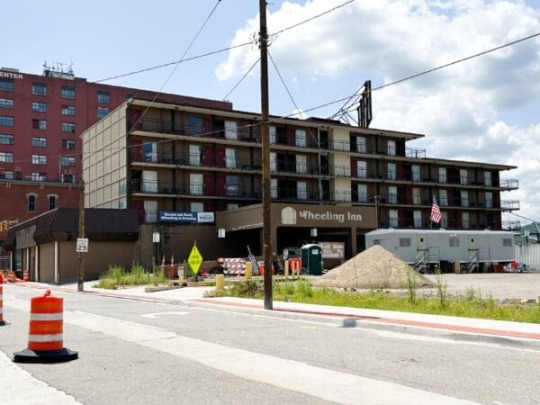
The long-anticipated remediation of the Wheeling Gateway Center is set to commence on Wednesday, July 10, which will be the first step into realizing the complete demolition of the former Wheeling Inn. The city has issued a notice to proceed to Raze International, LLC, the demolition company overseeing the project, and the perimeter of the site has been secured with construction fencing. Prior to mobilization, Raze filed a 10-day notification with the West Virginia Department of Environmental Protection (WVDEP), and has submitted a hazardous materials removal plan, which is being overseen by the project’s environmental engineers, Boggs and Montrose. Notification letters were also sent to the neighboring properties. “Our team is fully committed to executing this project with the highest standards of safety and efficiency,” said Debbie Brown, President of Raze International. “We appreciate the city and state’s support and collaboration as we embark on this important endeavor, especially with the on-going Streetscape road project.” On Wednesday at 12 p.m., the awning of the Wheeling Inn will be demolished for the purposes of providing adjacent truck access next to the former motel rooms, which will make it easier for crews to clean out the building. The media is invited to the site at this time, where they can set up to cover this first official remediation effort. “We are expecting an 8 week cleanup process and we will have our environmental engineers monitoring the work, said Frank O’Brien executive director of the Wheeling-Ohio County Convention Visitors Bureau. “We’re putting the project through the State’s Voluntary Remediation Program so that we can receive official documentation that certifies the clean-up was handled safely and properly.” O’Brien continued, “We ask for the community’s continued support and patience during these construction activities, and to be careful when driving near the site as vehicles are entering and leaving the project site.” Following the remediation and approvals to proceed by the State’s DEP, the building is expected to begin physical demolition in early September, and a groundbreaking celebration will be announced later this summer. Tipping Point is in the process of launching a live stream of the remediation and demolition process, so the community can take witness and celebrate progress of this historic moment for Wheeling’s gateway into downtown. The start time of the live stream will be announced on Tipping Point’s social media accounts. The Wheeling Gateway Center is a key redevelopment project aimed at creating a new heritage and visitor’s experience near the historic suspension bridge, which is at the primary entrance to downtown Wheeling, WV. The State of West Virginia’s Department of Tourism is working closely with the Wheeling-Ohio County Convention Visitors Bureau to establish final design concepts, which are anticipated to be released to the public in late summer or early fall. For more details and ongoing updates on the Wheeling Gateway Center project, please visit the Wheeling Gateway Center Community Hub. Read the full article
2 notes
·
View notes
Text
DevLog 3 | Revamping building system
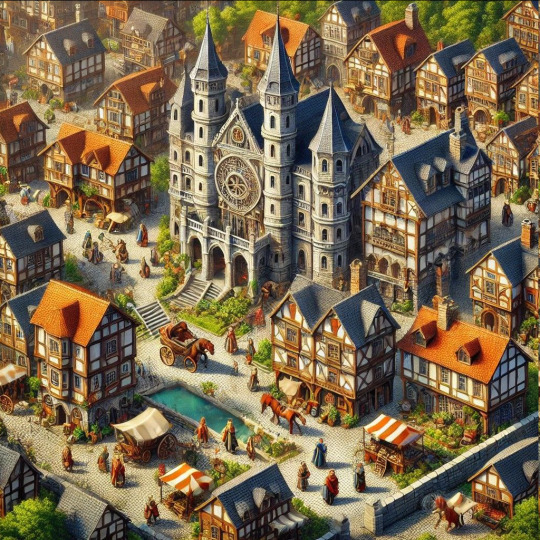
Hello everyone!
It's been a while since my last post. I've been swamped with work and didn't have much time to focus on the game or share any updates. But now, I'm back and ready to dive in!
In this post, I want to tell you about the upgraded building system. If you remember from my previous post, I completely revamped it from a free placement system to a new grid-based system. This new approach feels much better and has helped resolve a lot of issues. Let's dive into the details!
Why redeveloping?
When I first started developing the game, my goal was to provide players with unlimited freedom in placing buildings. I believed a grid-based system might restrict creativity and flexibility, so I opted for a free placement system. However, as development progressed, this decision began to present numerous challenges.
First of all, the free placement system was causing issues on a technical level. It was very demanding in terms of Z sorting and layering, making it extremely difficult to check for overlapping objects. This complexity arose because my game consists of both physical objects and tile objects (which are essentially not nodes). Managing these elements in a free placement environment proved to be a significant challenge.

Grid-based building system easily allows to check overlaps.
Second, the free placement system created challenges when I started developing the navigation system. I had to bake all the regions and areas each time a building was placed, which was not ideal for optimization and overall game performance.
Lastly, I realized how complex the free placement system was. While it has many advantages, the level of complexity it introduced didn't seem necessary for my chill city builder. Balancing creativity and simplicity became crucial, and the free placement system was tipping the scales too far towards complexity.
So, to sum up, the free placement system is indeed interesting and powerful, but the challenges it caused and the underutilized potential were the main reasons I decided to switch to a grid-based system. This new approach offers a better balance of functionality and simplicity, enhancing both development and gameplay experiences.

Free placement was not very accurate...
Redeveloped system
During the redevelopment, I realized that almost all my existing systems would be affected by this change:
- Building system
- Navigation system
- Road system
- And even data management
First, I started by creating a simple grid and covering my whole map with it. Then, I began mapping out the grid. Some objects, such as walls, rocks, and buildings, were considered obstacles. I had to perform calculations and update the data structure of my custom resources to store new values for the heights and weights of buildings in cells.

Whenever user tries to place a building grid shows tips - whether it is suitable place or not
The navigation system also changed. Previously, NPCs had a 'free roam' mode, but now their movement is based on the grid. For instance, diagonal movement is no longer possible. However, this change makes it much easier to identify and navigate around obstacles when needed.

Movement with a grid based system now works more seamlessly
The new grid-based building system makes it much easier to check for overlaps. Now, I don't need to worry about physics, areas, or colliders; I simply check a cell's coordinates to see if it contains any object. This change simplifies many aspects of development.
For example, I can now categorize cells into different dictionaries, such as building cells, road cells, and farm cells. This approach offers a lot of opportunities and flexibility for future development. Currently, I have a separate dictionary to store existing farm fields, which provides an easy and flexible way to add and create new farm fields.

You can make your farm as big as you wish.
Currently, the new grid-based building system feels much more convenient for me. It's easier to develop, easier to use, and offers more freedom and flexibility than my previous system. Does this grid-based system limit the user? Probably yes, but I don't think those limitations will be seen as extremely negative. In fact, the grid-based system feels much more natural to me at this point.
I hope this post has provided insight into why I chose to overhaul my building system and why I believe it significantly enhances my game compared to the previous system. While there will be further updates to the building system, I am already quite satisfied with the results. It feels like a significant leap forward in game development.
In the next post, I will shift focus away from development specifics and delve into my project routine regarding documentation, tickets, and overall management.
Thank you for reading, and please feel free to ask any questions!
6 notes
·
View notes
Text
In this excerpt from Superpredator: Bill Clinton’s Use and Abuse of Black America, we examine the Clintons’ involvement in the country’s affairs during Hillary Clinton’s time at the State Department.

Their actions in the country were shameful and shouldn’t be defended…
Bill and Hillary Clinton had long shared a personal interest in Haiti, dating back to the time of their honeymoon, part of which was spent in Port-au-Prince. In his autobiography, Bill says that his understanding of God and human nature were profoundly transformed when they witnessed a voodoo ceremony in which a woman bit the head off a live chicken. Hillary Clinton says the two of them “fell in love” with Haiti and they had developed a “deep connection” to the country. So when Hillary Clinton became Secretary of State in 2009, she consciously made the redevelopment of Haiti one of her top priorities. The country, she announced, would be a laboratory where the United States could “road-test new approaches to development,” taking advantage of what she termed “the power of proximity.” She intended to “make Haiti the proving ground for her vision of American power.” Hillary Clinton selected her own chief of staff, Cheryl Mills, to run the Haiti project.
Mills would be joined by Bill Clinton, who had been deputized by the U.N. as a “special envoy” to Haiti. Bill’s role was not well-defined, and Haitians were curious about what was in store. Mills wrote in an email to Hillary Clinton that Haitians saw Bill’s appointment as “a step toward putting Haiti in a protectorate or trusteeship status.” Soon, “joking that he must be coming back to lead a new colonial regime,” the Haitian media “dubbed him Le Gouverneur.”
The project was heavily focused on increasing Haiti’s appeal to foreign corporations. As Politico reported, Clinton’s experiment “had business at its center: Aid would be replaced by investment, the growth of which would in turn benefit the United States.”
One of the first acts in the new “business-centered” Haiti policy involved suppressing Haiti’s minimum wage. A 2009 Haitian law raised the minimum wage to 61 cents an hour, from 24 cents an hour previously. Haitian garment manufacturers, including contractors for Hanes and Levi Strauss, were furious, insisting that they were only willing to agree to a seven-cent increase. The manufacturers approached the U.S. State Department, who brought intense pressure to bear against Haitian President René Préval, working to “aggressively block” the 37-cent increase. The U.S. Deputy Mission Chief said a minimum-wage increase “did not take economic reality into account” and simply “appealed to the unemployed and underpaid masses.” But as Ryan Chittum of the Columbia Journalism Review explained, the proposed wage increase would have been only the most trivial additional expense for the American garment manufacturers:
As of last year Hanes had 3,200 Haitians making t-shirts for it. Paying each of them two bucks a day more would cost it about $1.6 million a year. Hanesbrands Incorporated made $211 million on $4.3 billion in sales last year, and presumably it would pass on at least some of its higher labor costs to consumers. Or better yet, Hanesbrands CEO Richard Noll could forego some of his rich compensation package. He could pay for the raises for those 3,200 t-shirt makers with just one-sixth of the $10 million in salary and bonus he raked in last year.
The truth of the “economic reality” was that the Haitian undergarment sector was hardly likely to become wildly less competitive as a result of the increase. The effort to suppress the minimum wage was not solely a Clinton project. It was also a “concerted effort on the part of Haitian elites, factory owners, free trade proponents, U.S. politicians, economists, and American companies.” But it was in keeping with the State Department’s priorities under Clinton, which prioritized creating a favorable business climate. It was that same familiar Clinton move “from aid to trade.” Bill Clinton’s program for Haitian development, designed by Oxford University economist Paul Collier, “had garment exports at its center.” Collier wrote that because of “propitious” factors like “poverty and [a] relatively unregulated labor market, Haiti has labor costs that are fully competitive with China.” But the Clintons’ role in Haiti would soon expand even further. In 2010, the country was struck by the worst earthquake in its history. The disaster killed 160,000 people and displaced over 1.5 million more.
(The consequences of the earthquake were exacerbated by the ruined state of the Haitian food economy, plus the concentration of unemployed Haitian farmers in Port-au-Prince.) Bill Clinton was soon put in charge of the U.S.-led recovery effort. He was appointed to head the Interim Haiti Recovery Commission (IHRC), which would oversee a wide range of rebuilding projects.
At President Obama’s request, Clinton and George W. Bush created the “Clinton-Bush Haiti Fund,” and began aggressively fundraising around the world to support Haiti in the earthquake’s aftermath. (With Hillary Clinton as Secretary of State overseeing the efforts of USAID, the Clintons’ importance to the recovery could not be overstated; Bill’s appointment meant that “at every stage of Haiti’s reconstruction—fundraising, oversight and allocation—a Clinton was now involved.”
Clinton announced that Haiti would be a laboratory where the United States could road-test new approaches to development, taking advantage of “the power of proximity.”
Despite appearances, the Clinton-Bush fund was not focused on providing traditional relief. As they wrote, “[w]hile other organizations in Haiti are using their resources to deliver immediate humanitarian aid, we are using our resources to focus on long-term development.” While the fund would advertise that “100% of donations go directly to relief efforts,” Clinton and Bush adopted an expansive definition of “relief” efforts, treating luring foreign investment and jobs as a crucial part of earthquake recovery. On their website, they spoke proudly of what the New York Daily News characterized as a program of “supporting longterm programs to develop Haiti’s business class.”
The strategy was an odd one. Port-au-Prince had been reduced to ruin, and Haitians were crowded into filthy tent cities, where many were dying of a cholera outbreak (which had itself been caused by the negligence of the United Nations). Whatever value building new garment factories may have had as a longterm economic plan, Haitians were faced with somewhat more pressing concerns like the basic provision of shelter and medicine, as well as the clearing of the thousands of tons of rubble that filled their streets.
The Clinton-led recovery was a disaster. A year after the earthquake, a stinging report from Oxfam singled out Clinton’s IHRC as creating a “quagmire of indecision and delay” that had made little progress toward successful earthquake recovery. Oxfam found that:
…less than half of the reconstruction aid promised by international donors has been disbursed. And while some of that money has been put toward temporary housing, almost none of the funds have been used for rubble removal.
Instead, the Clinton Foundation, IHRC, and State Department created what a Wall Street Journal writer called “a mishmash of low quality, poorly thought-out development experiments and half-finished projects.” A Haitian IHRC members lamented that the commission had produced “a disparate bunch of approved projects. . . [that] do not address as a whole either the emergency situation or the recovery, let alone the development, of Haiti.” A 2013 investigation by the Government Accountability Office found that most money for the recovery was not being dispersed, and that the projects that were being worked on were plagued by delays and cost overruns. Many Clinton projects were extravagant public relations affairs that quickly fizzled. For example, The Washington Post reported that:
…[a] 2011 housing expo that cost more than $2 million, including $500,000 from the Clinton Foundation, was supposed to be a model for thousands of new units but instead has resulted in little more than a few dozen abandoned model homes occupied by squatters.
Other Clinton ventures were seen as “disconnected from the realities of most people in the poorest country in the Western Hemisphere.” Politico reported that many Clinton projects “have primarily benefited wealthy foreigners and the island’s ruling elite, who needed little help to begin with.” For example, “the Clinton Bush Haiti Fund invested more than $2 million in the Royal Oasis Hotel, where a sleek suite with hardwood floors costs more than $200 a night and the shops sell $150 designer purses and $120 men’s dress shirts.”

Predictably, the Royal Oasis didn’t do an especially roaring trade; The Washington Post reported that “[o]ne recent afternoon, the hotel appeared largely empty, and with tourism hardly booming five years after the quake, locals fear it may be failing.”
In a country with a 30-cent minimum wage, investing recovery dollars in a luxury hotel was not just offensive, but economically daft.
Sometimes the recovery projects were accused not only of being pointless, but of being downright harmful. For instance, Bill Clinton had proudly announced that the Clinton Foundation would be funding the “construction of emergency storm shelters in Léogâne.” But an investigation of the shelters that the Foundation had actually built found that they were “shoddy and dangerous” and full of toxic mold.
The Nation discovered, among other things, that the temperature in the shelters reached over 100 degrees, causing children to experience headaches and eye irritations (which may have been compounded by the mold), and that the trailers showed high levels of carcinogenic formaldehyde, linked to asthma and other lung diseases.
The Clinton Foundation had subcontracted the building of the shelters to Clayton Homes, a firm that had already been sued in the United States by the Federal Emergency Management Administration (FEMA) for “having provided formaldehyde-laced trailers to Hurricane Katrina victims.” (Clayton Homes was owned by Warren Buffett’s Berkshire Hathaway, and Buffett had been a longstanding major donor to the Clinton Foundation.)
The Nation’s investigation reported on children whose classes were being held in Clinton Foundation trailers. Their semester had just been cut short, and the students sent home, because the temperature in the classrooms had grown unbearable. The misery of the students in the Clinton trailers was described:
Judith Seide, a student in Lubert’s sixth-grade class [explained that] she and her classmates regularly suffer from painful headaches in their new Clinton Foundation classroom. Every day, she said, her “head hurts and I feel it spinning and have to stop moving, otherwise I’d fall.” Her vision goes dark, as is the case with her classmate Judel, who sometimes can’t open his eyes because, said Seide, “he’s allergic to the heat.” Their teacher regularly relocates the class outside into the shade of the trailer because the swelter inside is insufferable.
Sitting in the sixth-grade classroom, student Mondialie Cineas, who dreams of becoming a nurse, said that three times a week the teacher gives her and her classmates painkillers so that they can make it through the school day. “At noon, the class gets so hot, kids get headaches,” the 12-year-old said, wiping beads of sweat from her brow. She is worried because “the kids feel sick, can’t work, can’t advance to succeed.”
The most notorious post-earthquake development project, however, was the Caracol industrial park. The park was pitched as a major job creator, part of the goal of helping Haiti “build back better” than it was before.
The State Department touted the prospect of 100,000 new jobs for Haitians, with Hillary Clinton promising 65,000 jobs within five years. The industrial park followed the Clintons’ preexisting development model for Haiti: public/private partnerships with a heavy emphasis on the garment industry.
Even though there were still hundreds of thousands of evacuees living in tents, the project was based on “the more expansive view that, in a desperately poor country where traditional foreign aid has chronically failed, fostering economic development is as important as replacing what fell down.” Much of the planning was focused on trying to lure a South Korean clothing manufacturer to set up shop there, by plying them with U.S. taxpayer funding.
The Caracol project was “the centerpiece” of the U.S.’s recovery effort. A gala celebrating its opening featured the Clintons and Sean Penn, and it was treated as the emblem of the new, “better” Haiti, that would demonstrate the country’s commitment to being “open for business.” In order to build the park, hundreds of poor farmers were evicted from their land, so that millions of dollars could be spent transforming it.
But the project was a terrible disappointment. After four years, it was only operating at 10% capacity, and the jobs had failed to materialize:
Far from 100,000 jobs—or even the 60,000 promised within five years of the park’s opening— Caracol currently employs just 5,479 people full time. That comes out to roughly $55,000 in investment per job created so far; or, to put it another way, about 30 times more per job than the average [Caracol] worker makes per year. The park, built on the site of a former U.S. Marine-run slave labor camp during the 1915-1934 U.S. occupation, has the best-paved roads and manicured sidewalks in the country, but most of the land remains vacant.
Most of the seized farmland went unused, then, and even for the remaining farmers, “surges of wastewater have caused floods and spoiled crops.” Huge queues of unemployed Haitians stood daily in front of the factory, awaiting jobs that did not exist. The Washington Post described the scene:
Each morning, crowds line up outside the park’s big front gate, which is guarded by four men in crisp khaki uniforms carrying shotguns. They wait in a sliver of shade next to a cinder-block wall, many holding résumés in envelopes. Most said they have been coming every day for months, waiting for jobs that pay about $5 a day. From his envelope, Jean Mito Palvetus, 27, pulled out a diploma attesting that he had completed 200 hours of training with the U.S. Agency for International Development on an industrial sewing machine. “I have three kids and a wife, and I can’t support them,” he said, sweating in the hot morning sun. “I have a diploma, but I still can’t get a job here. I still have nothing.”
For some, the Caracol project perfectly symbolized the Clinton approach: big promises, an emphasis on sweatshops, incompetent management, and little concern for the actual impact on Haitians. “Caracol is a prime example of bad help,” as one Haiti scholar put it. “The interests of the market, the interest of foreigners are prioritized over the majority of people who are impoverished in Haiti.”
But, failure as it may have been, the Caracol factory was among the more successful of the projects, insofar as it actually came into existence.
A large amount of the money raised by Bill Clinton after the earthquake, and pledged by the U.S. under Hillary Clinton, simply disappeared without a trace, its whereabouts unknown.
As Politico explained:
Even Bill’s U.N. Office of the Special Envoy couldn’t track where all of [it] went—and the truth is that still today no one really knows how much money was spent “rebuilding” Haiti. Many initial pledges never materialized. A whopping $465 million of the relief money went through the Pentagon, which spent it on deployment of U.S. troops—20,000 at the high water mark, many of whom never set foot on Haitian soil.
That money included fuel for ships and planes, helicopter repairs and inscrutables such as an $18,000 contract for a jungle gym… Huge contracts were doled out to the usual array of major contractors, including a $16.7 million logistics contract whose partners included Agility Public Warehousing KSC, a Kuwaiti firm that was supposed to have been blacklisted from doing business with Washington after a 2009 indictment alleging a conspiracy to defraud the U.S. government during the Iraq War.
The recovery under the Clintons became notorious for its mismanagement. Clinton staffers “had no idea what Haiti was like and had no sensitivity to the Haitians.” They were reportedly rude and condescending toward Haitians, even refusing to admit Haitian government ministers to meetings about recovery plans.
While the Clintons called in high-profile consulting firms like McKinsey to draw up plans, they had little interest in listening to Haitians themselves.
The former Haitian prime minister spoke of a “weak” American staff who were “more interested in supporting Clinton than helping Haiti.”
One of those shocked by the failure of the recovery effort was Chelsea Clinton, who wrote a detailed email to her parents in which she said that while Haitians were trying to help themselves, every part of the international aid effort, both governmental and nongovernmental, was falling short. “The incompetence is mind numbing,” she wrote. Chelsea produced a detailed memorandum recommending drastic steps that needed to be taken in order to get the recovery on track. But the memo was kept within the Clinton family, released only later under a Freedom of Information Act disclosure of Hillary’s State Department correspondence.
If it had come out at the time, as Haiti journalist Jonathan Katz writes, it “would have obliterated the public narrative of helpful outsiders saving grateful earthquake survivors that her mother’s State Department was working so hard to promote.”
The Clintons’ Haiti recovery ended with a whimper. The Clinton-Bush Haiti Fund distributed the last of its funds in 2012 and disbanded, without any attempt at further fundraising. The IHRC “quietly closed their doors” in October of 2011, even though little progress had been made. As the Boston Review’s Jake Johnston explained, though hundreds of thousands remained displaced, the IHRC wiped its hands of the housing situation:
[L]ittle remained of the grand plans to build thousands of new homes. Instead, those left homeless would be given a small, one-time rental subsidy of about $500. These subsidies, funded by a number of different aid agencies, were meant to give private companies the incentive to invest in building houses. As efforts to rebuild whole neighborhoods faltered, the rental subsidies turned Haitians into consumers, and the housing problem was handed over to the private sector.
The Clintons themselves simply stopped speaking about Haiti..
After the first two years, they were “nowhere to be seen” there, despite Hillary’s having promised that her commitment to Haiti would long outlast her tenure as Secretary of State. Haiti has been given little attention during Hillary Clinton’s presidential campaign, even though the Haiti project was ostensibly one of great pride for both Clintons.
The widespread consensus among observers is that the Haiti recovery, which TIME called the U.S.’s “compassionate invasion,” was a catastrophically mismanaged disappointment. Jonathan Katz writes that “it’s hard to find anyone these days who looks back on the U.S.-led response to the January 12, 2010, Haiti earthquake as a success.” While plenty of money was channeled into the country, it largely went to what were “little more than small pilot projects—a new set of basketball hoops and a model elementary school here, a functioning factory there.”
The widespread consensus is that the Haiti recovery was a catastrophically mismanaged disappointment.
The end result has been that little has changed for Haiti. “Haitians find themselves in a social and economic situation that is worse than before the earthquake,” reports a Belgian photojournalist who has spent 10 years in Haiti:
Everyone says that they’re living in worse conditions than before… When you look at the history of humanitarian relief, there’s never been a situation when such a small country has been the target of such a massive influx of money and assistance in such a short span of time… On paper, with that much money in a territory the size of Haiti, we should have witnessed miracles; there should have been results.
“If anything, they appear worse off,” says Foreign Policy of Haiti’s farmers. “I really cannot understand how you could raise so much money, put a former U.S. president in charge, and get this outcome,” said one Haitian official. Indeed, the money donated and invested was extraordinary. But nobody seems to know where it has gone.
Haitians direct much of the blame toward the Clintons.
As a former Haitian government official who worked on the recovery said, “[t]here is a lot of resentment about Clinton here. People have not seen results. . .. They say that Clinton used Haiti.” Haitians “increasingly complain that Clinton-backed projects have often helped the country’s elite and international business investors more than they have helped poor ‘Haitians.” There is a “suspicion that their motives are more to make a profit in Haiti than to help it.” And that while “striking a populist pose, in practice they were attracted to power in Haiti.”
But perhaps we should be more forgiving of the Clintons’ conduct during the Haitian recovery. After all, instead of doing true harm, the Clintons simply failed to do much good. And perhaps it’s better to have a luxury hotel than not to have one, better to have a few jobs than none at all. Thanks to Bill Clinton, there’s a gleaming new industrial park, albeit one operating at a fraction of its capacity.
Yet it’s a mistake to measure Clinton against what would have happened if the United States had done nothing at all for Haiti. The question is what would have happened if a capable, nonfamous administrator, rather than a globetrotting narcissist, had been placed in charge.
Tens of millions of dollars were donated toward the Haiti recovery by people across the world; it was an incredible outpouring of generosity. The squandering of that money on half-baked development schemes (mainly led by cronies), and the ignoring of Haitians’ own demands, mean that Clinton may have caused considerable harm through his failure.
Plenty of people died in tent cities that would not have died if the world’s donations had been used effectively
Democrats have bristled at recent attempts by Donald Trump to criticize Hillary Clinton over her record in Haiti. Jonathan Katz, whose in-depth reporting from Haiti was stingingly critical of the Clintons, has now changed his tune, insisting that we all bear the responsibility for the failed recovery effort. When Trump accused the Clintons of squandering millions building “a sweatshop” in Haiti in the form of the Caracol park, media fact-checkers quickly insisted he was spewing Pinocchios.
The Washington Post said that while Clinton Foundation donors may have financially benefited from the factory-building project, they benefited “writ large” rather than “directly.” The Post cited the words of the factory’s spokesman as evidence that the factory was not a sweatshop, and pointed out that Caracol workers earned at least “minimum wage” (failing to mention that minimum wage in Haiti remains well under a dollar). PolitiFact also rated the sweatshop claim “mostly false,” even though Katz notes “long hours, tough conditions, and low pay” at the factory and PolitiFact acknowledges the “ongoing theft of legally-earned wages.”
Defending the Clintons’ Haiti record is an impossible endeavor, one Democrats should probably not bother attempting. As the Center for Economic and Policy Research, which has studied the recovery, noted, when it comes to the Clinton-led recovery mission, “it’s hard to say it’s been anything other than a failure.” Haitians are not delusional in their resentment of the Clintons; they have good reason to feel as if they were used for publicity, and discarded by the Clintons when they became inconvenient.
None of this means that one should vote for Donald Trump for president. His tears for Haiti are those of a highly opportunistic crocodile, and his interest in the country’s wellbeing began at the precise moment that it could be used a bludgeon with which to beat his political opponent. As we have previously noted in this publication, one does not need to be convinced that Hillary Clinton is an honorable person in order to be convinced that she is the preferable candidate. It is important, however, not to maintain any illusions, not to stifle or massage the truth in the service of short-term electoral concerns. It remains simultaneously true that a Clinton presidency is our present least-worst option and that what the Clintons did to Haiti was callous, selfish, and indefensible.
More on Clinton involvement in Haiti can be found in Superpredator: Bill Clinton’s Use and Abuse of Black America.
#What The Clintons Did To Haiti#Haiti#clinton foundation#theft of a nation#superpredator#Superpredator: Bill Clinton’s Use and Abuse of Black America.
3 notes
·
View notes
Text
does read more work on mobile now
going kind of insane because 89 people are confirmed dead now on maui and i've read the most horrific stories of people who nearly burned alive or drowned or succumbed to hypothermia in the water or smoke/fume inhalation and there were no warning sirens or alerts or anything and there are reportedly hundreds of people still missing and communication is still down and there's no electricity or drinkable water and it's the deadliest wildfire in us history in more than a century and people still in west maui (who are more or less stranded there now) have not received basically any gov't help and the people are relying on themselves and that's really hard to do when you're on a fucking island with basically one road connecting you to the rest of it and that road has not been open consistently. this is the most horrific loss of life and thousands of people are displaced. and kanaka maoli are so worried that the big resorts and corporations are going to use this as a way to redevelop the land and further dispossess them. they don't trust the gov't and they don't really have a reason to. i'm just so angry and distressed and it's occupying all of my brain space. it feels like maybe because news about this has been coming out so slowly and because this place is pretty isolated that people aren't giving this the attention it urgently needs. been looking at what a lot of locals are posting on ig and it's just awful. the people who live there really really need all the fucking help they can get, they need it now and they need it for a long time to come. the people who are the least to blame for the climate crisis are suffering the most. americans came to this land to colonize it and turn it into a tourist haven and use up all the water resources for golf courses and force kanaka maoli to the margins and price them out of their homes and build ritz-carltons on their burial sites. but when tragedy strikes they are left to fend for themselves. i want to scream i've been crying so much i'm part of the problem i feel so much despair
8 notes
·
View notes
Text
Avalon
We are back in Bucharest and meeting up with the Avalon Cruise which is the main focus of this trip.
We move from our small hotel in the heart of the old town to a large upscale hotel north of there.
I take advantage os the new location to check out the local sights.
The Athenaeum is right across the street. It's the main concert hall in town.

Across the street from that is the old royal palace. It's now a series of museums. I bought a ticket to the Historical Museum thinking this was the historical art museum, but it was the reception rooms of the palace.

I have little interest in royal buildings anymore. They aren't interesting, just showy. So I spent a few minutes walking through the rooms and headed back to the ticket office to buy a ticket to the historical art museum.
Romania has an odd history, at least to me. It dates back to the Roman conquest and earlier, but then it goes silent for about a thousand years when it was on the edges of the Ottoman and Hungarian empires and a road for all the Asian nomads on their way to Europe.
So the historical art all started about 1300 through 1700's. It was all religious Icons and such. I find a little of that interesting, but after a while it's just more of the same.
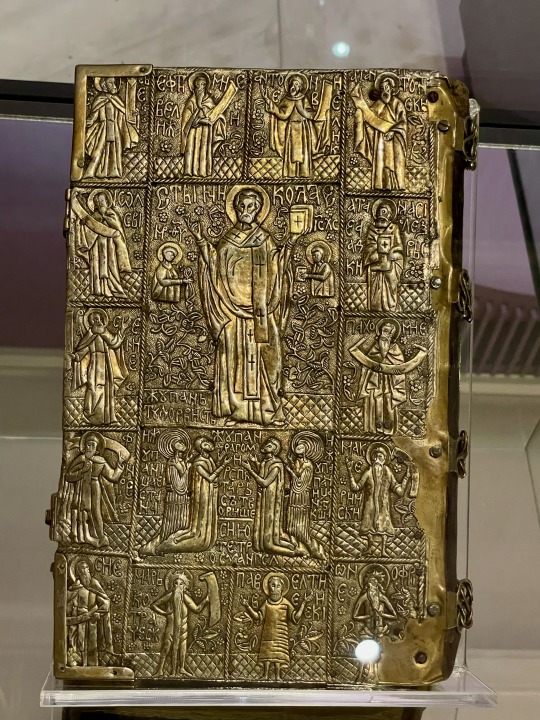
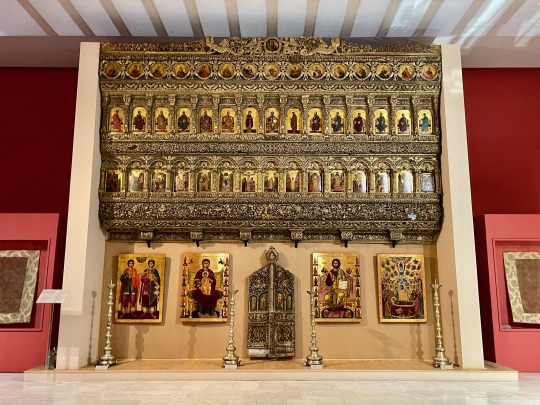
So that didn't take long either.
In the evening we met the group for the cruise and got the bad news. The water levels in the Danube are low and the boat can't get to our scheduled embarkation point. So we will be in hotels for an extra night and travel upstream by bus to meet the ship.
It was noted that Upstream of Bucharest the Danube in also too low and some of those cruises are now entirely bus trips. So it could be worse. But the continual changing of hotels is hard for Cathie and we chose the river cruise to avoid that.
I also find the bus trips annoying. First taking photos from the bus is terrible. You get shot windows of good shots and have the reflections in the windows. They never seem to stop for photos.
Secondly is the fact that you hear the continual chatter all around you. The complaints about taxes and regulations, how much money young people want to make. I listed to one group complaining about people wanting $15 and hour to work in coffee shops and restaurants. So I wondered how that related to the $2 an hour I made in college part-time and summer jobs. It turns out that $2 an hour in 1970 is equal to about $15 an hour today. Huh!
Our bus went to Transylvania. Our first stop was Peles Castle. This is the castle built by King Carol I, who the Romanians recruited from Germany to be their first king in the 1860's.
He spent his own money to build a very ornate very Bavarian Castle, making sure to buy the most expensive materials.
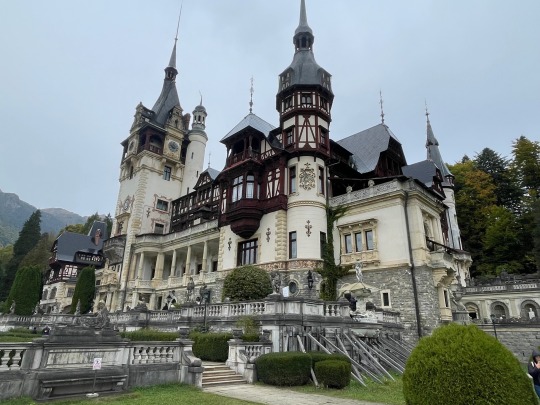
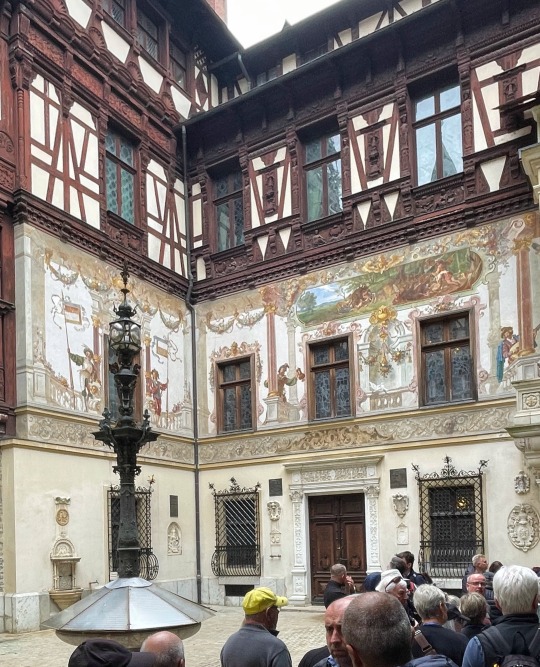
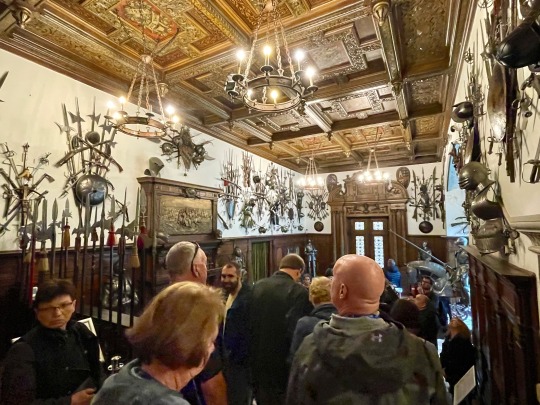
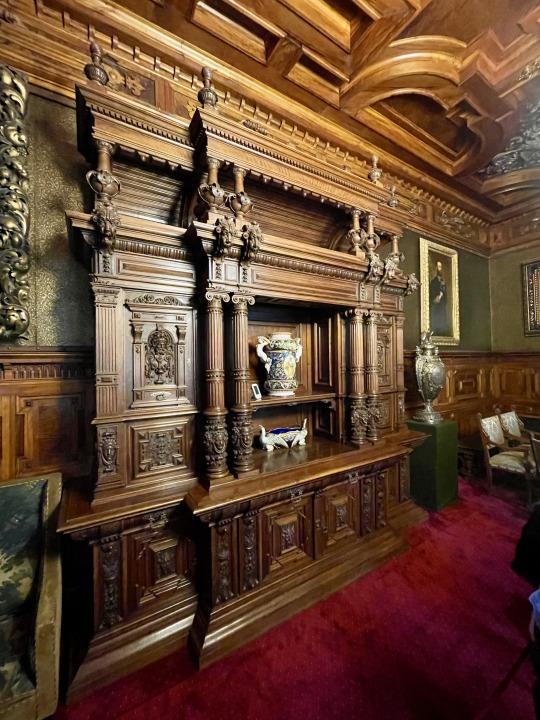
Well, it is substantial work, but it doesn't do anything for me. He made sure to use foreign craftsmen for all the work, apparently having no confidence in the abilities of the people of the country of which he was now king.
Then we drove through the Carpathian Mountains, which a more interesting than you can really tell from a bus. Arriving in Brasov for the night. Brasov is the second largest city in Romania.
It's an interesting town, surrounded by mountains on all sides. Under the communists, it was a factory town building tractors and such in huge factories. All of that fell apart after the fall of the communist regime. But the old factories are being demolished and the areas redeveloped. The city has a 100% electric transit system, has rebuilt the roads with modern roundabouts and such.
The old town in the center is also nice with a collection of building in various styles.
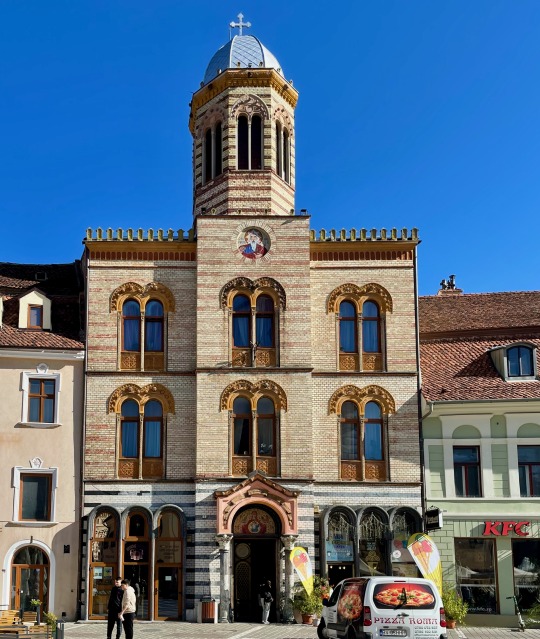
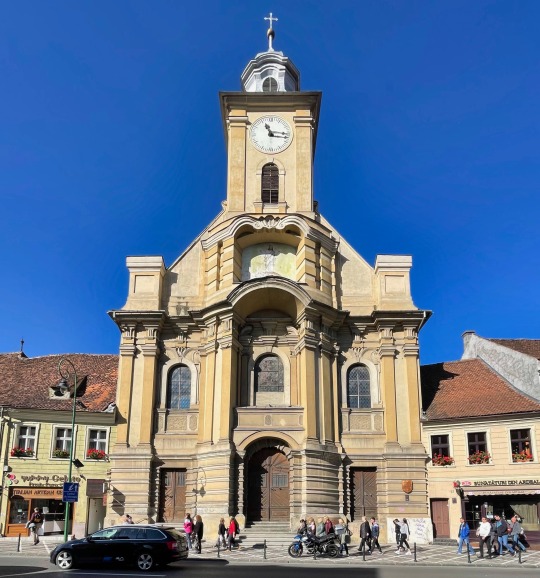
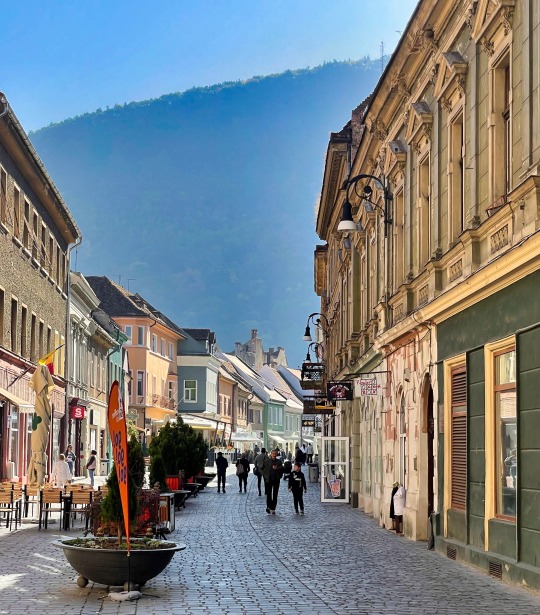
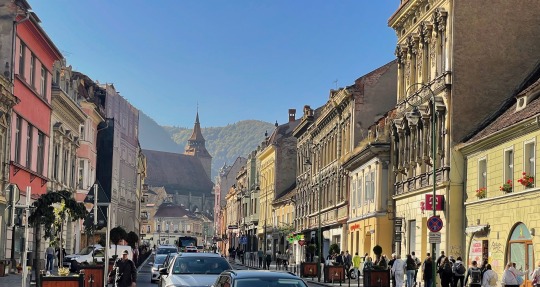
There are pedestrian streets with lots of shops, cafes, and restaurants and all in all a pleasant place.
Transylvania was settled in large part by German immigrants brought in by the Hungarian Kings who ruled at the time. So this area is Lutheran rather than the Orthodox on the west side of the mountains. Brasov has a large gothic cathedral that was originally Catholic but became Lutheran in the reformation.

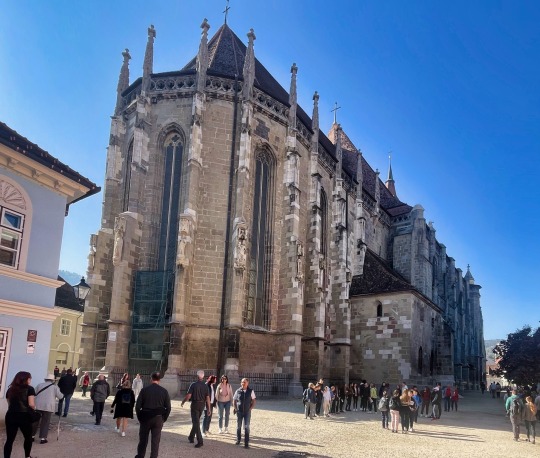


The Germans were brought in to build fortified towns to protect the area from Ottoman incursions from the east.
We visited the town of Prejmer, with the old fortified center still preserved.

It was a walled citadel surrounding a church. On the inside of the walls were several stories of rooms, one for each family in town, where they could stay during a siege.
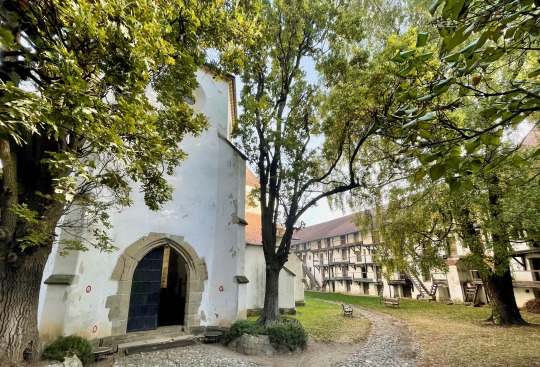
The church itself would constitute a final refuge if the fortifications were breached.
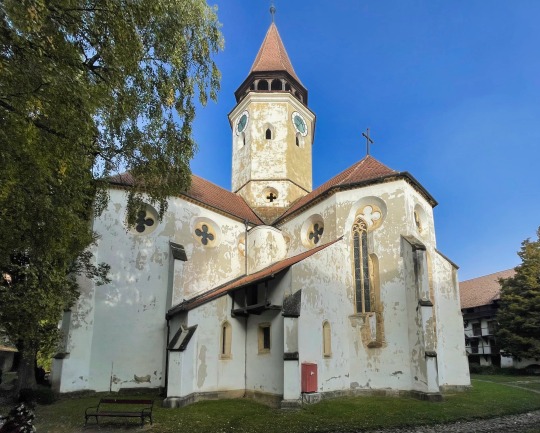
The wall had a roofed gallery around the top with arrow slots and such every few feet. I had never seen a fortification with this design. But most assume that soldiers are defending a castle. Here the citizens are defending their town and it looks like there was room for every man in town to participate in the defense.
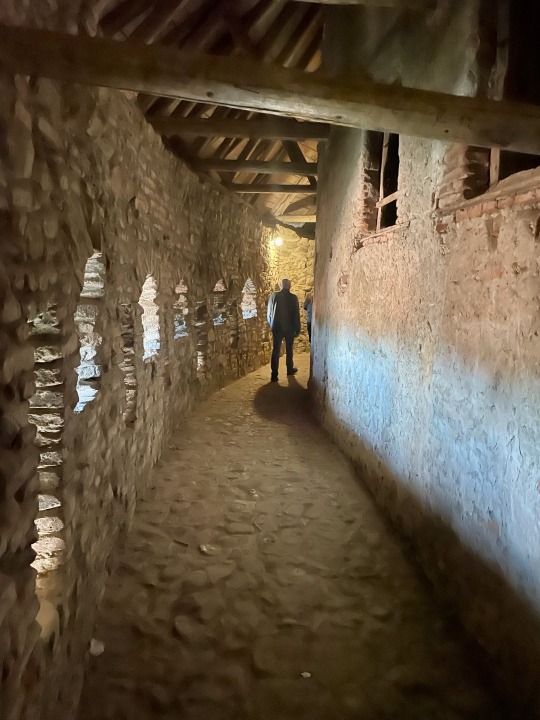
Our last stop in Transylvania was Bran Castle, of course. It's the most popular tourist site in Romania. Of course the stories associated with the castle are almost all wrong.
It was not Vlad Dracula's castle. He only spent two nights there, and that was as a prisoner. His domain was on the other side of the mountains.
It is a pretty simply decorated castle, as its main purpose was defense.
Luckily Avalon paid for a private tour after closing time. So the huge crowds that are normally there were gone and it was just our small group.

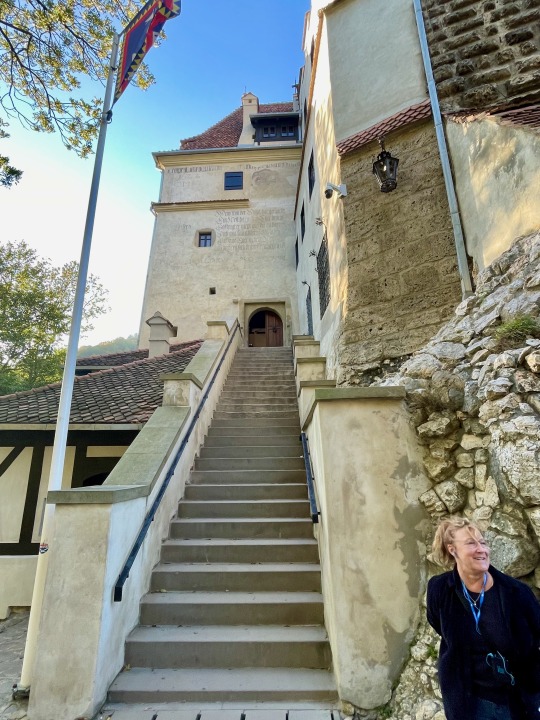

There were lots of steep narrow stairs, so it was a good thing that Cathie decided to skip this tour.
But it does have great views of the fall colors in the surrounding mountains.
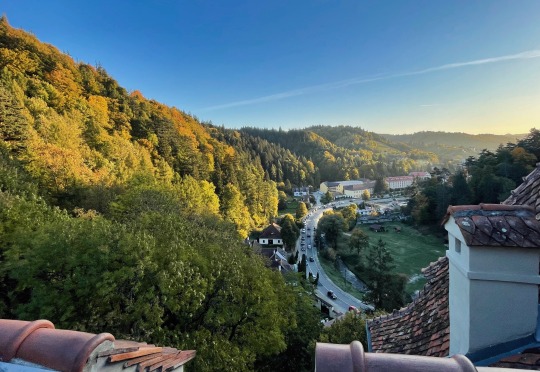
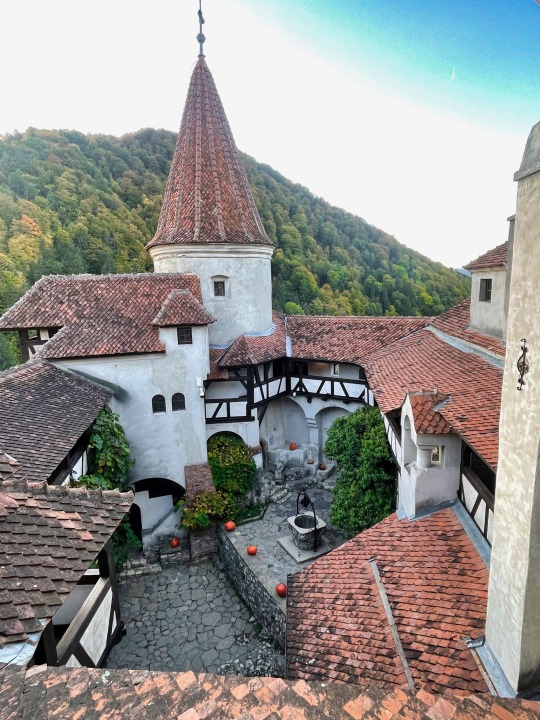
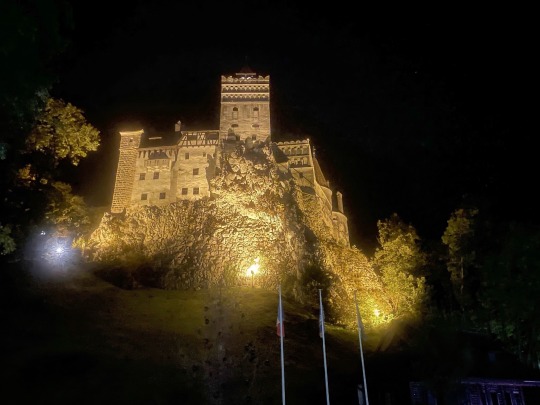
We have traveled back to Bucharest for one night and tomorrow we drive for several hours in hopes of finding our riverboat where the water is still deep enough,
4 notes
·
View notes